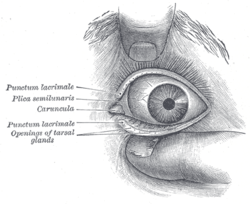Meibomian gland
| Meibomian gland | |
|---|---|
 Front of left eye with eyelids separated to show medial canthus and openings of tarsal (meibomian) glands. | |
| Details | |
| Identifiers | |
| Latin | glandulae tarsales |
| MeSH | A09.371.337.614 |
| TA | A15.2.07.042 |
| FMA | 71872 |
The meibomian glands (or tarsal glands) are a special kind of sebaceous gland at the rim of the eyelids inside the tarsal plate, responsible for the supply of meibum, an oily substance that prevents evaporation of the eye's tear film. Meibum prevents tear spillage onto the cheek, trapping tears between the oiled edge and the eyeball, and makes the closed lids airtight.[1] There are approximately 50 glands on the upper eyelids and 25 glands on the lower eyelids.
Dysfunctional meibomian glands often cause dry eyes, one of the more common eye conditions. They may also contribute to blepharitis.
Function
Meibum
Lipids
Lipids are the major components of meibum (also known as "meibomian gland secretions"). The term "meibum" was originally introduced by Nicolaides et al. in 1981.[2]
The biochemical composition of meibum is extremely complex and very different from that of sebum. Lipids are universally recognized as major components of human and animal meibum. Recently, an update on the composition of human meibum and on the structures of various positively identified meibomian lipids was published.[3]
Currently, the most sensitive and informative approach to lipidomic analysis of meibum is mass spectrometry either with direct infusion[4] or in combination with liquid chromatography.[5]
Proteins
In humans, more than 90 different proteins have been identified in meibomian gland secretions.[6]
Clinical significance
Dysfunctional meibomian glands often cause dry eyes, one of the more common eye conditions. They may also contribute to blepharitis. Inflammation of the meibomian glands (also known as meibomitis, meibomian gland dysfunction, or posterior blepharitis) causes the glands to be obstructed by thick waxy secretions. Besides leading to dry eyes, the obstructions can be degraded by bacterial lipases, resulting in the formation of free fatty acids, which irritate the eyes and sometimes cause punctate keratopathy.
![Meibomian glands in the lower eyelid imaged under amber light to show vasculature support and the gland structure [epiCam].](../I/m/Meibomian-glands.png)
Meibomian gland dysfunction is more often seen in women and is regarded as the main cause of dry eye disease.[7][8] Factors that contribute to meibomian gland dysfunction can include things such as a person's age and/or hormones.[9] Treatment can include warm compresses or expression of the gland by a professional. In some cases antibiotics or steroids are prescribed.
History
The glands are named after Heinrich Meibom (1638–1700), a German physician.
See also
References
- ↑ "eye, human." Encyclopædia Britannica. Encyclopaedia Britannica Ultimate Reference Suite. Chicago: Encyclopædia Britannica, 2010.
- ↑ Nicolaides, N; Kaitaranta, JK; Rawdah, TN; Macy, JI; Boswell, FM; Smith, RE (Apr 1981). "Meibomian gland studies: comparison of steer and human lipids". Invest Ophthalmol Vis Sci. 20 (4): 522–536. PMID 7194326.
- ↑ Butovich IA (November 2009). "The Meibomian puzzle: combining pieces together". Prog Retin Eye Res. 28 (6): 483–498. doi:10.1016/j.preteyeres.2009.07.002. PMC 2783885
 . PMID 19660571.
. PMID 19660571. - ↑ Chen, JZ (2010). "Shotgun lipidomic analysis of human meibomian gland secretions with electrospray ionization tandem mass spectrometry". Invest Ophthalmol Vis Sci. 51 (12): 6220–6231. doi:10.1167/iovs.10-5687. PMID 20671273.
- ↑ Butovich, IA (2009). "Lipidomic analysis of human meibum using HPLC-MSn". Methods Mol Biol. 579: 221–246. doi:10.1007/978-1-60761-322-0_11. PMID 19763478.
- ↑ Tsai, PS; Evans, JE; Green, KM; Sullivan, RM; Schaumberg, DA; Richards, SM; Dana, MR; Sullivan, DA (March 2006). "Proteomic analysis of human meibomian gland secretions". Br J Ophthalmol. 90 (3): 372–7. doi:10.1136/bjo.2005.080846. PMC 1856970
 . PMID 16488965.
. PMID 16488965. - ↑ "Managing and Making Sense of MGD". Review of Ophtamology. 2012. Retrieved 26 February 2014.
- ↑ "Rethinking Meibomian Gland Dysfunction: How to Spot It, Stage It and Treat It". American Academy of Ophthalmology. 2014. Retrieved February 26, 2014.
- ↑ "The Role of Meibomian Gland Dysfunction and Lid Wiper Epitheliopathy in Dry Eye Disease". American Academy of Optometry. 2012. Retrieved February 26, 2014.
External links
- synd/541 at Who Named It?
- Rethinking Meibomian Gland Dysfunction: How to Spot It, Stage It and Treat It